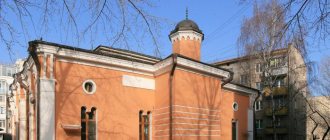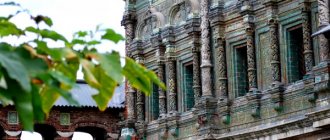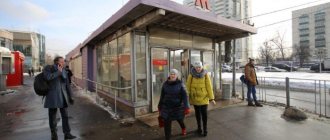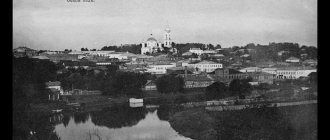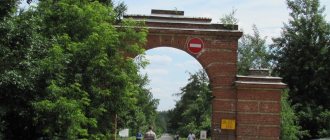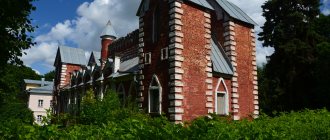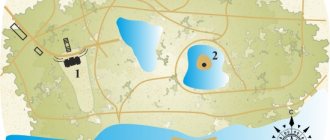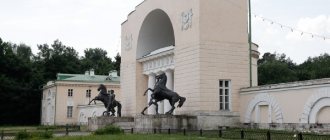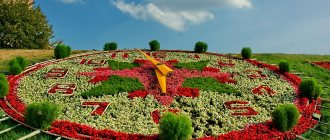Sestroretsk is a famous resort near St. Petersburg, located on the shores of the Gulf of Finland. People come here for treatment, because here there are deposits of mineral water and healing mud. And tourists, in turn, are looking in Sestroretsk for the very place where the leader of the world proletariat Lenin was hiding, beautiful views by the water, ancient dachas, walks in the parks and in the Sestroretsk Swamp reserve. It’s convenient that you can see all the sights of the town in one day, albeit if you arrive by car. It is better to divide your trip on your own into two days.
"Sestroretsk swamp"
Sestroretsk has the largest specially protected natural area in St. Petersburg. For example, the beautiful bird of prey osprey lives here; it is listed in the Red Book of the International Union for Conservation of Nature. Also, for many years, one of the largest colonies of black-headed gulls in the Leningrad region has been living in the swamp. In total, about 162 species of birds live in the Sestroretskoe Bog reserve.
The reserve is located on the shore of the Sestroretsk flood. An eco-trail has been laid on its territory, most of which passes through a pine forest. From comfortable wooden decks you can see the main types of bogs. There are observation platforms and information stands along the route, from which you can learn about local animals, birds and plants.
The best way to get here is from the Beloozero if you are not traveling by car.
Nature and infrastructure of the park
Between the experimental dacha of the Timiryazev Academy and the Big Garden Pond lies the old landscape park Dubki. On the shore of the pond there is a small oak grove of natural origin.
The entire area of the park can be speculatively divided into a number of remarkable parts: a decorative pond, the Church of St. Nicholas the Wonderworker, a memorial, playgrounds for children, a sports sector and special areas for walking dogs.
At the end of the 20th century, serious restoration work and repairs of all structures were done in Dubki. The real pearl of the park is the restored wooden church of St. Nicholas the Wonderworker, erected in 1915 by the famous architect of that time F. O. Shekhtel. This church is still operational.
In addition to oak trees, the park has two specially planted rows of Norway maple. There are pine trees, Tatarian maple, horse chestnut, bird cherry, larches, birches, ash and rowan. Hawthorn grows in the form of a trimmed hedge.
Honeysuckle, viburnum, lilac and thuja are planted in groups. There are three alleys of linden trees and a grotto with Empire style columns. Dubki Park is an element of the Petrovsko-Razumovskoye nature reserve; it is a protected monument of landscape gardening art.
On the territory of Dubkov there are two beaches: on one you can sunbathe on the grass, on the other on the sand, a boat station and comfortable changing rooms. Twenty years ago you could swim in the pond, but now only dogs are bathed there.
There is a small wooden bridge across the channel of the pond. The banks themselves are reinforced with piles of logs. Fishermen can often be seen. In summer, there are cool fountains and ducks swimming here, who happily accept treats from visitors.
The infrastructure for recreation is also well developed: many playgrounds, a wooden town with many slides, fun attractions for small and adult visitors: cars, airplanes, a train, a trampoline, a pool with inflatable ducks for swimming.
By the standards of Moscow, Dubki Park is small, but clean and carefully looked after. New trees are planted in the park every year.
In honor of the soldiers from the Timiryazevsky district who died in the war with Nazi Germany, a memorial memorial was erected in Dubki Park on Victory Day in 2000.
You can ride ponies and ordinary horses, and in winter you can ride in a sleigh on virgin snow. For those who are hungry, a cozy restaurant “Ratnik” is open on site.
Temple of the Holy Chief Apostles Peter and Paul
The first church in Sestroretsk was built in 1725. It burned down five years later and was restored in the second half of the 19th century. The stone temple became one of the most impressive buildings in the resort town at that time.
The modern temple stands in a different place - on the shore of Petrovskaya Embankment. During Soviet times, the former church was demolished and a school was built in its place, which still operates today. The new white stone building is made in the style of ancient Russian architecture. Nearby there is a bell tower with a hip roof.
Address: Petrovskaya embankment, 1
History of creation
Dubki Park is a typical oak forest near Moscow. Its history began when Peter I decided to create his own summer residence in the Moscow region.
Park "Oaks" Timiryazevskaya - oak grove in the Lianozovsky forest park
On the site of the future Dubki park, not far from the Sisters River, a small imperial palace was built according to the requirements of Dutch park art. At the same time, lawns, canals and small ponds appeared. There were also fountains in the plans, but the project was not implemented.
And after the death of the emperor, the park fell into decay. Over time, the dilapidated palace was dismantled. In 1986, the Dubki park appeared. Only 2 picturesque ponds, connected by a narrow channel, remind of the royal time. There is a wooden bridge across it.
On the anniversary of the 55th anniversary of the victory, a memorial was erected in the park in memory of the residents of the Timiryazevsky district who died on the fronts of the Great Patriotic War. And the real decoration of the park is the oak alley. It is under the protection of UNESCO. In 2005, the park was given the status of a Natural Historical Park.
In March 2021, in close proximity to the oak grove, construction began on the 22-story residential complex “Timiryazev Park”. The cutting down of several dozen century-old oak trees caused mass protests by local residents, who were harshly dispersed by construction security guards in cooperation with the police.
Some park defenders received injuries of varying severity. The legality of the construction is being challenged in court
In 2021, large-scale reconstruction, comprehensive landscaping and landscaping of the Dubki natural-historical zone in northern Moscow began.
In the central part of the park, the rotunda will be put in order and all transit routes will be updated. New lights with energy-saving lamps, as well as benches and trash cans will be installed along the paths.
Planned works include additional landscaping and the construction of a multifunctional pavilion in the park, under the roof of which rental and security points, administration and toilets will be located.
Ostap Bender People's Literary Museum
You can end your walk around Sestroretsk on a cheerful note, namely, go to visit the leader of the “Union of Sword and Plowshare”. In the resort town there is a small but cozy museum in honor of the hero of the work of Ilf and Petrov, Ostap Bender.
The museum is located in the city's Central Children's Library. Here you can visit the interiors of the “Horns and Hooves” office, sit at the Commander’s table, hold the “Koreiko case” in your hands and even get “the key to the apartment where the money is.”
Among the exhibits: rare materials about the prototype of Ostap Bender and household items from the 1920s and 30s. For example, the pince-nez of Kisa Vorobyaninov, the strainer of Madame Gritsatsueva, the scarf and headdress of the “ideological fighter for banknotes.”
Address: st. Tokareva, 10
Visit by prior arrangement by phone 293-77-74.
Dubki: tree funeral
Campaign “Save Oaks!” in defense of Dubki Park and against the illegal construction of the residential complex “On Ivanovskaya”, which is being carried out on the territory adjacent to the park - Ivanovskaya Street, building 19, took place today, March 6, 2021. As part of the action, residents of the area staged a procession with mourning signs in memory of 35 dead trees, barbarously cut down on the night of March 1-2 by order of the developer of a new residential complex. After which a meeting took place with the adoption of a resolution.
“We, of course, did great: we staged an action and adopted a resolution. Was the developer given a notice of moratorium?
And the second question: the holidays will end, and they will probably continue their dirty work. Surely, on the night of March 9, bulldozers and excavators will be driven into the site. Are we going to prevent this somehow?”
Residents of the area are convinced that permission to build a house at Ivanovskaya, building 19 was issued in violation of their right to a favorable environment - public hearings and meetings with residents on this issue were not held. Also, the historical significance of Ivanovskaya Street, which at the beginning of the 20th century was part of a holiday village, was not taken into account. At one of these dachas, Pasternak wrote his famous poem “A Candle Was Burning on the Table.” More than 2,500 signatures from area residents have already been collected in defense of the park, more than 5,000 signatures in electronic form. Timiryazev residents intend to fight for the preservation of Dubki Park, in which more than one generation of Muscovites grew up.
Dubki Park is a monument of landscape gardening art that is in danger of extinction. A multi-storey complex with underground parking is being built near the historical park. Organizers: initiative group of district residents, deputies of the municipal assembly. Dubki Park is a cultural heritage zone of the city of Moscow, a favorite vacation spot not only for residents of the Timiryazevsky district, but also for neighboring ones; his story is dear to every Timiryazevite. Participants of the action will walk through the park with lit candles and lay flowers on the 100-year-old oak trees that have already died under the developer’s saw. The park's oak alley is also under threat: according to an environmental report, the planned high-rise will block the path to groundwater, and this will lead to the inevitable death of the trees in the near future. Thus, high-rise construction near the park on Nemchinov Street, which began in 1985, has already destroyed about 100 oak trees.
A gigantic new building with underground parking will disrupt not only the visual perception of the park, but also the environmental situation in the entire area. “Oak trees” are called the lungs of these places. It is not for nothing that in the 50s, on the very spot where trees have already been cut down today and scaffolding has been erected, a kindergarten for children with pulmonary diseases was built. In addition, “Dubki” is a monument of landscape gardening art and an object of cultural significance of federal significance; construction of objects with a height of more than 20 meters is prohibited next to it!
Park "Dubki", the history of its appearance. Modern park and its entertainment.
Moscow does not have a good environment.
And if it weren’t for the numerous parks, squares, rivers and lakes, it would be very bad. Thanks to large planting areas, Muscovites and guests of the capital have the opportunity to relax and breathe clean air. One of these places is Dubki Park. And although this name appeared approximately half a century ago, this area has its own history, which begins in the 19th century. In those days there was a gorgeous oak grove here. Park “Dubki” in the 19th century.
In the middle of the grove there was a lake consisting of three parts. This reservoir was not independent, but was part of the water exchange system in the north of Moscow. And now, according to some information, it connects with the waters of the Kopytovka River, and through it with the Ostankino and Farmer ponds. And all this using a system of underground collectors. Previously, there was a connection with the Astradam and Olenii ponds through the Zhabenka River. Significant changes began after 1861, when the Petrovsko-Razumovskaya estate became the property of the Forestry Academy. They began to cut down parts of the grove and conduct summer cottage construction there, laying new driveways and roads. It turns out that the Moscow Zoo was originally planned to be built not on Krasnaya Presnya, but here. A beautiful lake, a gorgeous forest - ideal conditions, but a small amount of work needed to be done. The distance to the center of the capital was large, and for this sole reason, the mayors of Moscow decided that the public would not travel that far.
The next stage of history: after 1945.
After the end of the Great Patriotic War, the grove was almost completely cut down. One person, Mironov, a former landscaping and landscaping engineer, came to the defense. He began defending the ancient oak grove to officials. He involved students, pensioners, schoolchildren, and, in general, the entire local population, in the struggle. They stopped cutting down and even planted new plantings: young oaks, lilacs, and ornamental varieties of shrubs and trees. The ponds began to be put in order. The name of the revived park was given by the oak trees. In the 80s, they wanted to build up this area with residential buildings, but again caring people defended it. In those same years, a large amount of improvement work was carried out here. After cleaning the ponds, many springs clogged. They built a children's playground. It was soon destroyed, but then restored again. Recently, these places were thoroughly renovated, and now Dubki Park is a favorite place for recreation and walks for all residents.
Modern recreation park.
Now we have a nice, cozy park, which with its area of 18 hectares is part of the large Petrovsko-Razumovskoye nature reserve. Before us is a typical oak forest near Moscow. Remote from highways and roads, open plan, with many paths and paths. There are two ponds on the territory, connected by a channel with a bridge. They are reinforced and decorated with environmentally friendly wooden stilts. In summer you can feed ducks in the ponds and there are fountains. Swimming is prohibited. What else is Dubki Park famous for in Moscow? The main attraction, of course, is the oak alley with centuries-old oak trees. There is an amusement area where children can ride horses on weekends. In winter, the nearby hill turns into an excellent slide, from which those who wish can go down on skis and sleds. On the territory of the park there is a famous memorial in honor of the 55th anniversary of the Victory of the Soviet people in the Great Patriotic War. If you visit Dubki Park regularly and for a long time, you undoubtedly have a photo of this place. Every year young trees are planted here, renewing the area and making it even more comfortable and well-groomed. The public can relax in the cafe or on one of the benches. Family and children can have a great time.
Exotic relaxation in the park: sauna.
Park visitors who love saunas have the opportunity to visit such an establishment here. Park “Dubki” lures you to its sauna, made in an exotic form. The lounge in the establishment is designed in the form of a cave, the walls are completely made of stone, stalactites hang from the ceiling, which adds realism to the design of the room. A table and sofa fit perfectly in the seating area located on the edge of the pool. There is a banquet area with a wooden table and benches, fenced off from everything else by a wicker fence. It is equipped with all modern communications: satellite television, video and audio equipment. The Finnish steam room can simultaneously accommodate up to ten visitors. Brooms and aromatherapy are at your service. Then - to the luxurious pool, where you can not only take a dip, but also swim. This establishment hosts wedding banquets, corporate events, celebrates anniversaries, birthdays, and families with children. The festive table will offer you European cuisine and a wide selection of drinks. You will enjoy your stay in the sauna and will remember it for a long time.
Location and how to get there.
Where is Dubki Park located? Moscow, Nemchinov street, next to Timiryazevskaya metro station. Having arrived by metro, you need to walk from it along the pedestrian street, on the left go around the shopping center and four Soviet-era panel houses. The landmark is a wooden temple located at the entrance to the park. In the event that you go to a vacation spot by car, focus on the address: Ivanovskaya Street, building No. 3, which is located directly at the entrance. Here, in the yard, you can leave your car.
